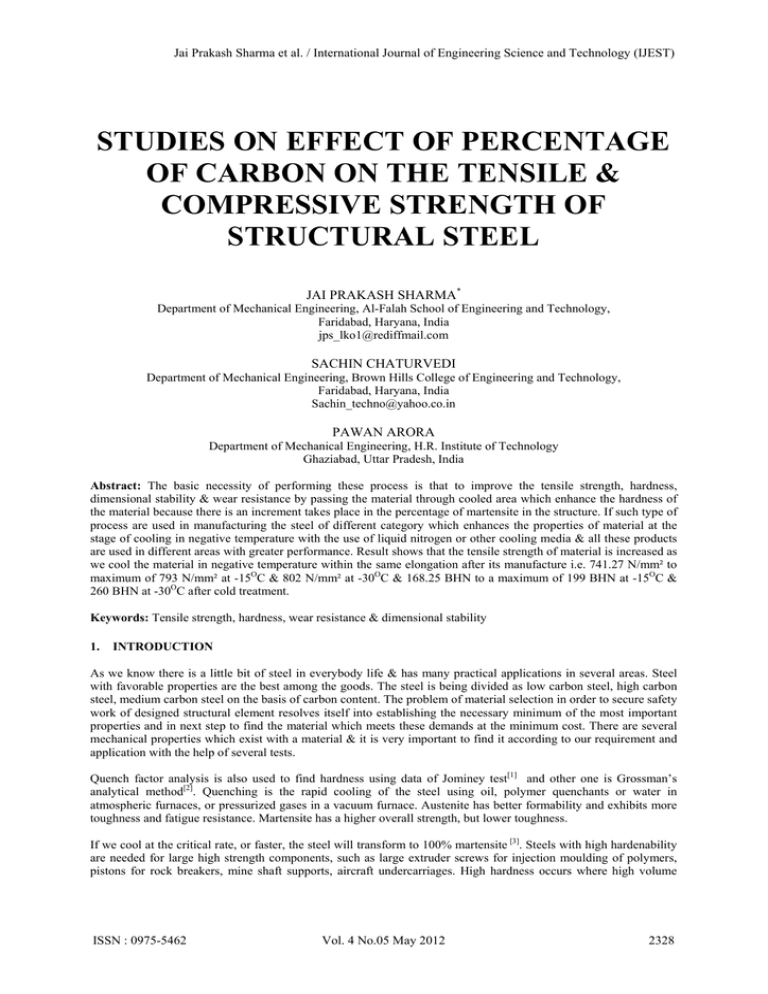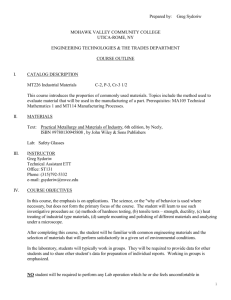STUDIES ON EFFECT OF PERCENTAGE OF CARBON ON THE TENSILE &
advertisement

Jai Prakash Sharma et al. / International Journal of Engineering Science and Technology (IJEST) STUDIES ON EFFECT OF PERCENTAGE OF CARBON ON THE TENSILE & COMPRESSIVE STRENGTH OF STRUCTURAL STEEL JAI PRAKASH SHARMA* Department of Mechanical Engineering, Al-Falah School of Engineering and Technology, Faridabad, Haryana, India jps_lko1@rediffmail.com SACHIN CHATURVEDI Department of Mechanical Engineering, Brown Hills College of Engineering and Technology, Faridabad, Haryana, India Sachin_techno@yahoo.co.in PAWAN ARORA Department of Mechanical Engineering, H.R. Institute of Technology Ghaziabad, Uttar Pradesh, India Abstract: The basic necessity of performing these process is that to improve the tensile strength, hardness, dimensional stability & wear resistance by passing the material through cooled area which enhance the hardness of the material because there is an increment takes place in the percentage of martensite in the structure. If such type of process are used in manufacturing the steel of different category which enhances the properties of material at the stage of cooling in negative temperature with the use of liquid nitrogen or other cooling media & all these products are used in different areas with greater performance. Result shows that the tensile strength of material is increased as we cool the material in negative temperature within the same elongation after its manufacture i.e. 741.27 N/mm² to maximum of 793 N/mm² at -15OC & 802 N/mm² at -30OC & 168.25 BHN to a maximum of 199 BHN at -15OC & 260 BHN at -30OC after cold treatment. Keywords: Tensile strength, hardness, wear resistance & dimensional stability 1. INTRODUCTION As we know there is a little bit of steel in everybody life & has many practical applications in several areas. Steel with favorable properties are the best among the goods. The steel is being divided as low carbon steel, high carbon steel, medium carbon steel on the basis of carbon content. The problem of material selection in order to secure safety work of designed structural element resolves itself into establishing the necessary minimum of the most important properties and in next step to find the material which meets these demands at the minimum cost. There are several mechanical properties which exist with a material & it is very important to find it according to our requirement and application with the help of several tests. Quench factor analysis is also used to find hardness using data of Jominey test[1] and other one is Grossman’s analytical method[2]. Quenching is the rapid cooling of the steel using oil, polymer quenchants or water in atmospheric furnaces, or pressurized gases in a vacuum furnace. Austenite has better formability and exhibits more toughness and fatigue resistance. Martensite has a higher overall strength, but lower toughness. If we cool at the critical rate, or faster, the steel will transform to 100% martensite [3]. Steels with high hardenability are needed for large high strength components, such as large extruder screws for injection moulding of polymers, pistons for rock breakers, mine shaft supports, aircraft undercarriages. High hardness occurs where high volume ISSN : 0975-5462 Vol. 4 No.05 May 2012 2328 Jai Prakash Sharma et al. / International Journal of Engineering Science and Technology (IJEST) fractions of martensite develop. Lower hardness indicates transformation to bainite or ferrite/pearlite microstructures. Increasing the austenite grain size therefore decreases the available nucleation sites, which retards the rate of the ferrite/pearlite phase transformation [4]. This method of increasing the hardenability is rarely used because substantial increases in hardenability require large austenite grain size, obtained through high austenitizing temperatures. The resultant microstructure is quite coarse, with reduced toughness and ductility. However, the austenite grain size can be affected by other stages in the processing of steel, and, therefore, the hardenability of a steel also depends on the previous stages used in its production. 2. LITERATURE REVIEW The steel material used for this investigation is a medium carbon steel & mechanical properties investigated were, the tensile strength and hardness. Everyone knows that these properties can be obtained by controlling several parameters during its manufacturing process but with this paper I want to show that the tensile strength & hardness can be increased after its manufacture by the application of cold treatment of steel for a specific period of time. Since standard test procedures were used, standard test specimens were prepared for all the tests. A set of specimens was prepared for conducting pre & post cold treatment investigations after its manufacturing. The average taken represents the results recorded in the Tables 3 & 4. 3. METHODOLOGY 3.1. Properties Investigated The properties investigated and the methods used have been summarized in Table 1. Properties Tensile strength Hardness Mode of evaluation UTM of 1000 kN Brinell hardness testing machine Table 1. Methods used in determining the properties 4. EXPERIMENTAL SETUP 4.1. Tensile Test The tensile test is a standard test which was conducted using the UTM testing machine. The test specimens were as specified in Table 1. From the tests, the yield and tensile strengths, the percentage elongation and the percentage reduction in area were determined. The tensile strength is given according to Pearce (1977)(5) as UTS = P max Where P / Ao max = maximum load applied A = Original Cross sectional area. o The percentage elongation after fracture is given as ε % = ℓ - ℓ x 100 /ℓ u o o Where ℓ = the original gauge length o ℓ = the final gauge length. u 4.2 Hardness Test The hardness of the specimen is indicated by the depth of penetration of the indenter on the steel specimen. This was read directly from the calibrated dial gauge of the machine. ISSN : 0975-5462 Vol. 4 No.05 May 2012 2329 Jai Prakash Sharma et al. / International Journal of Engineering Science and Technology (IJEST) 4.3 Cold treatment The specimen was cold treated at maintaining the specimen at -15oC & -30oC temperature for one day. 5. STUDY OF MECHANICAL PROPERTIES As the objective of the project is to compare the mechanical properties of various heat treated cast iron Specimens, now the specimens were sent to hardness testing and tensile testing. 5.1. Hardness Testing The specimen’s hardness was measured by means of Brinell Hardness Tester. The procedure adopted can be listed as follows: 1. 2. 3. First the brale indenter was inserted in the machine; the load is adjusted to3000N. The load was first applied to seat of the specimen. Now with the help of camera take the image of spot made by indentor on the specimen, the diameter of the spot was taken automatically by the computer & with the help of software, the hardness of specimen was calculated. 5.2. Ultimate Tensile Strength Testing The specimens were treated in UTS Machine for obtaining the % elongation, Ultimate Tensile Strength, yield Strength. The procedures for obtaining these values can be listed as follows: 1. 2. 3. 4. 5. At first the cross section area of the specimen was measured by means of an electronic slide caliper and then the gauge length was calculated. Now the distance between the jaws of the UTS was fixed to the gauge length of the specimen. The specimen was gripped by the jaws of the holder. The maximum load was set at 150 KN. The specimen was loaded till it fails. 6. RESULTS 6.1 Chemical Composition The purpose of analyzing the chemical composition of the steel sample is to enable its classification to be made. Based on Table 1, the steel can be classified as medium carbon steel, since both AISI and SAE classified steel whose carbon content ranges between 0.32-0.48%, manganese content ranges between 0.60-0.9% and maximum sulphur content of 0.05% to be medium carbon steel. The steel composition also satisfies the minimum carbon point requirement for it to be materially affected by heat treatment, since it has 36 points of carbon which is higher than 25 (Lindberg 1977)(6). The analysis which is carried out on steel having the chemical composition is shown below: ISSN : 0975-5462 Vol. 4 No.05 May 2012 2330 Jai Prakash Sharma et al. / International Journal of Engineering Science and Technology (IJEST) Metal Name Percentage Iron 97.92 Carbon 0.445 Silicon 0.31 Manganese 0.71 Sulphur 0.034 Phosphorus 0.034 Nickel 0.084 Chromium 0.13 Molybdenum 0.014 Aluminum 0.013 Copper 0.285 Titanium 0.005 Niobium 0.001 Cobalt 0.006 Boron 0.0001 Lead 0.002 Vanadium Zirconium 0.001 0.003 Table 2. Composition of materials (7) As we can see that the percentage of carbon is 0.045%, which means that it is medium carbon steel. Cooling can be achieved in a variety of ways, liquid nitrogen, mechanical & CO2 as dry ice have also been widely used for this purpose. The process time is about 1 hour per 25 mm (1 in.) of cross section of material. Technicians can cold-treat different alloys and part sizes together as long as the processing time for the largest part is used. Once the processing temperature is reached uniformly throughout the part, no further changes in microstructure are expected by increasing the processing time [8]. As the material is quenched and cools under negative temperature i.e. -70 to -120. The Mechanical properties of the specimens which were not cold-treated are presented in Table 3. This allows for a good comparison of the sample to be made with those obtained elsewhere. The properties of the cold-treated specimens are also presented in Table 4. Sr. no Yield Strength (N/mm²) Tensile Strength (N/mm²) Yield stress (N/mm2) Percentage Elongation (%) 1. 2. 3. 4. Average 498.8 478.9 483.5 498.8 490 750.7 704.6 756.8 753 741.27 498.8 478.9 483.5 498.8 490 47.2 47.4 46.5 48.2 47.32 BHN (load is 29,430 N/mm2) 167 169 170 167 168.25 Elongation (%) 20 20.5 18.3 22.5 20.32 Table 3. Properties of Medium Carbon Steel (9) 6.2 Pretreatment Properties The properties of the medium carbon steel which is not cold treated are presented in Table 3. For the purpose of comparison, the values of yield strength, tensile strength, elongation and reduction in area are in close comparison. This material can find applications in axles, gears and drop forgings. ISSN : 0975-5462 Vol. 4 No.05 May 2012 2331 Jai Prakash Sharma et al. / International Journal of Engineering Science and Technology (IJEST) 6.3 Properties of cold-treated Specimens The steel material with approximate 0.44 percent carbon when cooled to -15°C and -30°C for about 24 hours. There is increase in strength & hardness which was found out through applying tensile & Brinell hardness test. Sr. no 1. 2. Tensile strength(N/mm2) 793 802 Yield stress 512 514 Brinell Hardness(load is 3000N) 199 HB 260 HB Temperature Elongation At -15 At -30 19.2 20.4 Table 4. Properties of Medium Carbon Steel after cooling (10) 7. DISCUSSION 7.1 Strength The strength values are higher than those obtained for the materials that are not cold treated after its manufacturing as we see the table 3 & 4, by making comparison between both the table the tensile strength & yield strength is increased. In table 2 the tensile strength is 741.27N/mm2 & it increases as we cool the material after its manufacture with the increased value in its tensile strength i.e. 793 N/mm2 at -15oC & 802 N/mm2 at -30oC. 7.2 Hardness The hardness values of the cold- treated specimens are generally higher than that of untreated steel. In this case, the ability of the material to resist plastic deformation under indentation was used to evaluate hardness. The highest value of hardness (260 HB at -30oC ) is obtained on cold treatment of steel. Graph 1. Load vs displacement, temperature is -15OC ISSN : 0975-5462 Vol. 4 No.05 May 2012 2332 Jai Prakash Sharma et al. / International Journal of Engineering Science and Technology (IJEST) Graph 1. Load vs displacement, temperature is -30OC 8. CONCLUSION 1. 2. 3. The 0.45% C medium carbon steels which were cold treated in this work showed a reasonable increase in both hardness and strength. The hardness of as received specimens increased from 168.25 BHN to a maximum of 199 BHN at -15OC & 260 BHN at -30OC during cold treatment after its manufacture. The UTS of as received specimen increased from 741.27 N/mm² to maximum of 793 N/mm² at -15OC & 802 N/mm² at -30OC during cold treatment. REFERENCES [1] [2] [3] [4] [5] [6] [7] [8] [9] [10] Telejko,H. Adrian, K. Skalny, M. Pakiet, R. Stasko, The Investigation Of Hardenability Of Low Alloy Structural Cast Steel, Journal Of Achievements In Materials And Manufacturing Engineering 37(2009)480-485. M.A. Grossmann, AIME Transactions, 1942, 150, 227-255. J.V.Tuma, J.Kranje The Temperature Distribution In The Superheater Tube, Engineering Research 66/4(2001) Pp 153-156 A Review On Jominy Test And Determination Of Effect Of Alloying Elements On Hardenability Of Steel Using Jominy End Quench Test. International Journal Of Advances In Engineering & Technology, July 2011. ©IJAET ISSN: 2231-1963 Pearce, R. 1977 Metrology: Tensile Testing, Metallurgia And Metal Forming, 534-7. Lakhtin, Y.M. 1977. Engineering Physical Metallurgy And Heat Treatment. Mir Publ. Lindberg. R.A. 1977. Processes And Materials O Manufacture, 2nd Edition. Allyn And Bacon, Boston, MD, USA. Spectro Analytical Labs Limited, New Delhi, Invoice No: 901710. Sub-Zero Treatment of Steels Technology/Processes/Equipment, Linde AG, Linde Gas Division, 82049 Höllriegelskreuth , German 43490875 0104 – 1.1 au. Spectro Analytical Labs Limited, New Delhi, Invoice No: 905191. National Testing Laboratory, Mangolpuri Industrial Area, Delhi, Report No:120425Cv181101. ISSN : 0975-5462 Vol. 4 No.05 May 2012 2333




